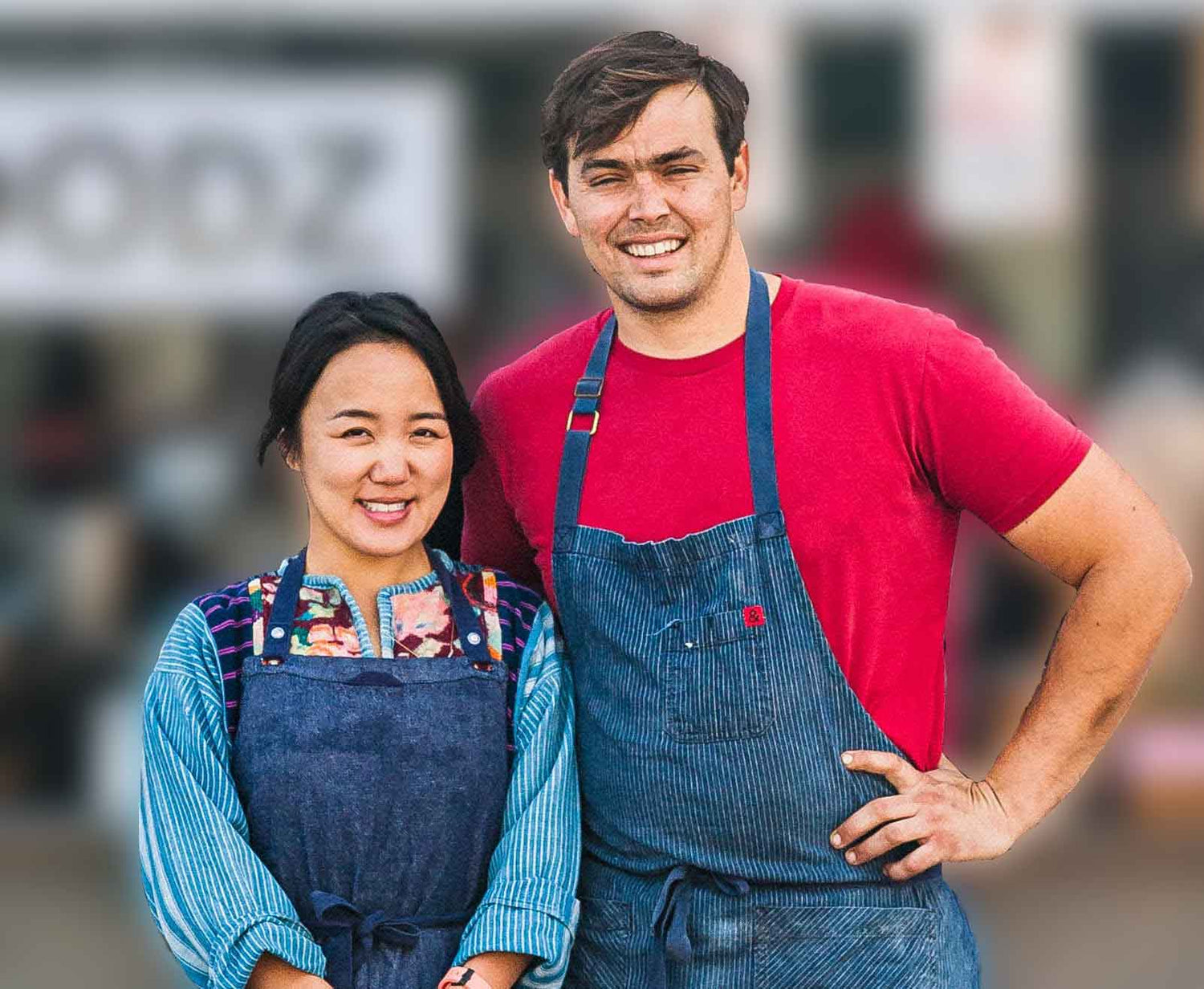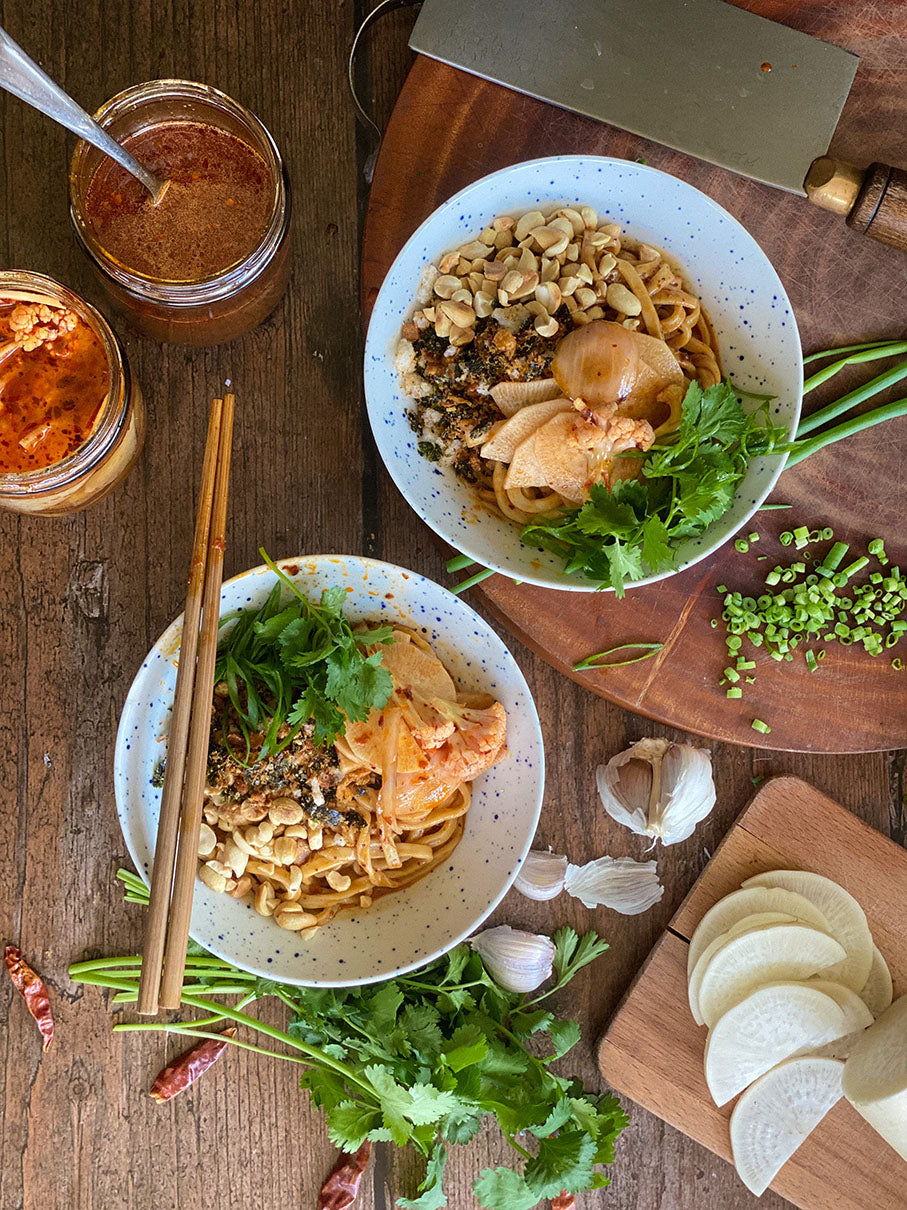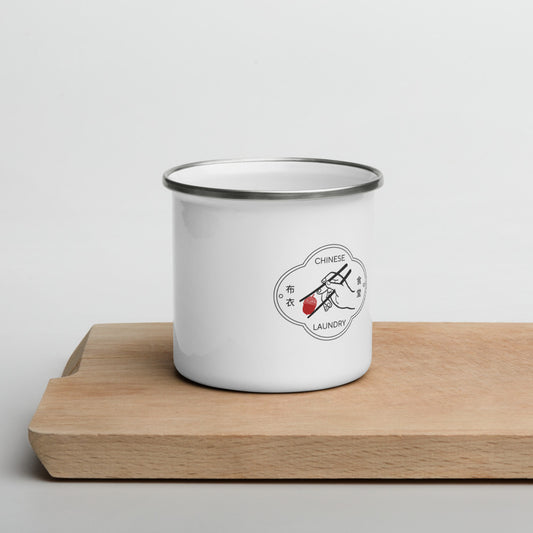-

Freakin Delicious!
Nutty (but nut free!), savory, spicy, umami, sweetly spiced, this luxuriously velvety, lava like sauce is so uniquely delicious!
-

Amazing on Everything!
What do you use it on? The real question is, what CAN'T you put it on?! Use it as a noodle sauce, pasta sauce, a dip, a spread, a dressing. Possibilities are endless!
-

Ready to Eat!
Requires no additional cooking or preparaion, and turns any ingredient or combination of ingredients into a flavorful dish in a matter of minutes.

A Celebration of Home
As a young child, Yanza’s grandfather would make a creamy spicy sesame noodle he called Dan Dan Noodles. Yanza’s grandparents were born and raised in Chengdu, Sichuan, a city in Southwestern China famed for its cuisine. Soon after the young couple married, they migrated thousands of miles to Northeastern China, where they would remain for over 4 decades. Due to the Cultural Revolution, they had to cut all ties and communications with their families back home. Recreating the taste of home became a remedy for homesickness. It was clear to Yanza even at a young age, that grandpa infused his longing for home into his Dan Dan Noodles by the way he lovingly told stories of his childhood as Yanza slurped on the noodles.
After moving to Los Angeles as an adult, Yanza would often make this noodle dish for her chef husband Leo while they shared stories about their childhoods. Eventually, Dan Dan Noodle became a crowd favorite at the food truck they co-founded together. Then during the 2020 pandemic lock downs, Yanza and Leo began selling this special sauce in jars so people could enjoy Dan Dan Noodles at home. Now, they’re excited to share it with you!
Dan Dan Sauce Jumbo Size - Sichuan Spicy Noodle Sauce
Share











Other Cool Things
-
CLK Chili Worship T-shirt, Hand Drawn and Designed by CLK
Regular price $36.00 USDRegular priceUnit price per -
Eco Tote Bag 100% Certified Organic Cotton
Regular price $29.00 USDRegular priceUnit price per -
Enamel Mug Lightweight Durable and Multifunctional
Regular price $29.00 USDRegular priceUnit price per -
CLK Chili Worship Sweat Shirt, Hand Drawn and Designed by CLK
Regular price $45.00 USDRegular priceUnit price per
Traditional Chinese Food & Dishes
Traditional Chinese food is a beautiful blend of tastes, textures, and colors that appeals to the senses, from flavorful stir-fries to delicate dumplings, every dish is mouthwatering. The fact that it acknowledges the extensive background, varied regional traditions, and individual cooking techniques that have been passed down from generation to generation is its defining characteristic. To make each recipe even more worth it, Chinese Laundry Kitchen comes with Dan Dan Sauce.
... Read MoreWhat is traditional Chinese food?
Traditional Chinese food refers to China's culinary traditions and practices that have been passed down through generations and represent the country's rich history, diversified culture, and regional variations. Chinese food is recognized for its robust flavors, innovative cooking methods, and use of fresh, seasonal ingredients.
Is traditional Chinese food healthy?
Yes, traditional Chinese cuisine frequently emphasizes a well-balanced diet that includes a range of foods in proper portions, such as cereals, vegetables, meats, and seafood. Many traditional Chinese cuisines include a variety of vegetables and use cooking methods such as stir-frying, steaming, and boiling, which can help to keep the nutritional value of the components.
What are some popular traditional Chinese dishes?
Some popular traditional Chinese dishes include the following:
- Peking Duck
- Kung Pao Chicken
- Dim Sum
- Mapo Tofu
- Fried Rice
- Hotpot
- Noodles
- Congee
Can vegetarians and vegans find options in traditional Chinese cuisine?
Yes, vegetarians and vegans can find options in traditional Chinese cuisine. Chinese cuisine has a rich tradition of vegetarian and vegan dishes that feature an abundance of vegetables, tofu, beans, and grains. Some traditional Chinese dishes that are commonly made without meat or animal products include:
- Vegetarian Dumplings (Jiaozi)
- Braised Tofu
- Ma Po Tofu (using vegetable protein or tofu instead of meat)
- Buddha's Delight (also known as Luohan Zhai or Lo Han Jai)
- Stir-Fried Vegetables
- Eggplant in Garlic Sauce (using vegetable protein instead of meat)
- Vegetarian Fried Rice
- Vegetarian noodles
What are some popular traditional Asian dishes?
Traditional Asian food is extremely diversified, spanning numerous countries and regions, each with its own distinct flavors, ingredients, and cooking styles. Here are some classic Asian meals from different countries:
- Sushi (Japan)
- Pho (Vietnam)
- Pad Thai (Thailand)
- Nasi Goreng (Indonesia)
- Kimchi (South Korea)
- Dumplings (China)
- Laksa (Malaysia)
- Biryani (India)
Is traditional Asian food always spicy?
No, traditional Asian food is not always spicy. While some Asian cuisines are known for their spicy flavors, such as Sichuan cuisine from China or Thai cuisine, not all traditional Asian dishes are spicy. Asian cuisine is incredibly diverse and varies greatly depending on the region, country, and even the specific dish being prepared.
How do I make traditional Asian dishes at home?
- Understanding the basic flavor components of a cuisine is key to reproducing an authentic ethnic recipe, regardless of where it’s from. First, try to get familiarized with the tastes and textures by tasting authentically made dishes at restaurants or during travels
- Understand the reason behind why certain tools, ingredients, or techniques are used. When those tools and techniques are not available, your understanding of why they have been used helps you come up with the appropriate alternatives.
- Depending on the origin of the recipe you chose, use seasonings and condiments made in the country or region of origin to get the most authentic result. When certain components are unavailable to you, replace them with what’s available and make adjustments to achieve a similar result to those missing ingredients would normally have.
- In many Asian cultures, sharing food is part of the tradition. This is why ingredients are often cut to bite-size. Learning the proper knife cuts not only helps you make the food look and taste more authentic but also helps you understand the purpose behind the cuts.
What ingredients are commonly used in traditional Chinese dishes?
The commonly used ingredients in traditional Chinese dishes include
- Soy sauce
- Oyster sauce
- Black rice vinegar
- Sesame oil
- Ginger
- Garlic
- Green onions
- Shaoxing wine (Chinese rice wine)
- Hoisin sauce
- Five-spice powder
- Cornstarch
Are traditional Chinese dishes typically spicy?
Not all traditional Chinese foods are hot and spicy, despite the fact that several regional Chinese cuisines—like those from Sichuan and Hunan—are renowned for their potent, hot flavors. Chinese food is extremely varied and changes significantly based on the region, cooking method, and particular dish.














